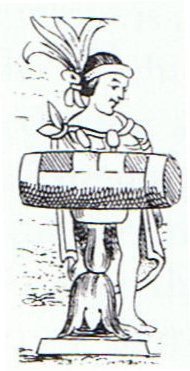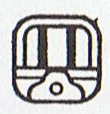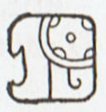The 'Fire' (ahi) held high in front in
Cb7-26 can be contrasted with the empty hand in Cb7-24 (where
560 = 80 weeks, possibly alluding to the day number for March
21):
|
October 1 |
2 |
3 |
4 (277) |
 |
 |
 |
 |
|
Cb7-24 (560) |
Cb7-25 |
Cb7-26 |
Cb7-27 |
|
tagata rima oho ki te kihikihi
- ki te ragi |
koia ra kua
mau - i te ahi |
e tagata rogo |
|
ψ Virginis
(194.5) |
Alioth (194.8),
Minelauva (195.1),
Cor Caroli (195.3), δ Muscae (196.5) |
Vindemiatrix (196.8),
ξ¹ Centauri (197.1) |
13h
(197.8) |
|
ξ²
Centauri (197.9) |
|
April 2 |
3 |
4 (460) |
5 |
|
Cih, λ Tucanae
(12.4) |
no stars listed |
1h
(15.2) |
|
β Phoenicis (15.1) |
These 4 glyphs are somewhat engimatic. Perhaps
they should be read as an introduction to line b8. At
Cb7-27 Metoro said e tagata rogo, which could
indicate he connected the glyph with a new year. In the
night sky of October 4 could be seen that the 25th
(Saturn) hour had been counted completely (tagata).
|
October 5 |
6 |
7
(280) |
8 |
9 |
 |
 |
 |
 |
 |
|
Cb8-1 (564) |
Cb8-2 |
Cb8-3 |
Cb8-4 |
Cb8-5 |
|
Hetu erua |
tagata rere ki te ragi |
te hokohuki |
te moko |
|
Apami-Atsa (198.5) |
Diadem (198.9), Al Dafīrah (199.4) |
σ
Virginis (200.4) |
ι
Centauri (201.4) |
Mizar (202.4) |
|
April 6 (462) |
7 |
8 (99) |
9 |
10 |
|
Al Batn Al Hūt-26 |
Revati-28 |
κ Tucanae (17.6) |
no star listed |
Ksora (20.1) |
|
υ Phoenicis, ι
Tucanae (15.6), ζ Phoenicis (15.7),
MIRACH (16.0),
Anunitum (16.5) |
REVATI (16.9), ν
Phoenicis (17.4) |
Regulus (461) |
Metoro's koia ra kua mau - i te ahi, is
at the end of the 25th RA hour, and the Sun disc is sagging
(old), not
rising up as in Cb8-1--2.
|
Raa
Sun; day; i te raá nei, today;
raá îka, good day for fishing. Vanaga.
1. Sun. 2. Day. 3. Time. 4. Name
of sub-tribe. Fischer.
Te
manu i te raá
= comet. Barthel.
'... The substitution of the sun for
the sail, both of which are called ra or
raa in Polynesia, is a remarkable feature in
Easter Island art ... ' Heyerdahl 3.
1. The sun;
raa ea mai,
raa puneki,
sunrise; raa tini,
raa toa,
noon. P Mgv., Ta.:
ra, the sun. Mq.:
a, id. 2.
Day, date; a raa nei
a, to-day, now;
raa i mua,
day before. P Mgv., Ta.:
ra, a
day. Mq.: a,
id. Churchill.
'...
The chief thus makes his appearance at Lakeba
from the sea, as a stranger to the land.
Disembarking at the capital village of Tubou,
he is led first to the chiefly house (vale levu)
and next day to the central ceremonial ground (raaraa)
of the island ...' (Islands of History)
Ta.:
toraaraa,
to raise up. Churchill 2. |
LA, s.
Haw., sun, light, day. N. Zeal.,
ra, sun, day. Marqu.,
a, id. Sam., la, id.
Deriv.: Haw., lae, be
light, clear, shining; lai,
shining as the surface of the
sea, calm, still; laelae
and lailai, intens. Sam.,
lelei, something very
good; lala, to shine;
lalangi, to broil. Fiji.,
rai, to see, appear;
rai-rai, a seer, a prophet.
Teor., la, sun. Aru
Islands, lara, id.;
rarie, bright, shining.
Amblaw., laei, sun, day.
Irish, la,
lae, day. Laghmani
(Cabul), la'e, day.
Sanskr.,
laj, lanj, to appear,
shine; râj, to shine.
Ved., to govern; s. a
king. If, as Benfey intimates,
the Sanskrit verb bhrâj, to
shine, to beam, is 'probably
abhi-râj', an already Vedic
contraction, then the Polynesian
root-word al and lae
will reappear in several of the
West Aryan dialects. Lat.,
flagrare, flamma,
flamen. Greek, φλεγω,
φλοξ.
A.-Sax., blac,
blæcan,
&c.
Probably the universal
Polynesian
lani,
langi,
rangi,
ra'i,
lanits
(Malg.) designating the upper
air, sky, heaven, and an epithet
of chiefs, refers itself to the
same original
la,
lai,
lanj,
referred to above, to which also
be referred:
Welsh,
glan,
clean pure, bright, holy. Sax.
clæne,
clean, pure. Swed.,
ren,
clean. pure;
grann
(?), fine, elegant.
It may be noted in connection
with this word, either as a
coincidence or as an instance of
ancient connection, that in the
old Chaldean the name of the sun
and of the Supreme Deity was
Ra,
and that in Egypt the sun was
also named
Ra.
LA²,
s. Haw., Sam., Tong.,
ra.
N. Zeal., the sail of a canoe;
abbreviated from, or itself an
older form of, the Fiji.
laca,
a sail, also the mats from which
the sails were made. Sunda.,
Mal.,
layar,
sail. Malg.,
laï,
sail, tent, flag.
Sanskr.,
lâta
(Pictet), a cloth;
latâ
(Benfey), a creeper, a plant;
lak-taka,
a rag. As mats and clothing in
primitive times were made of
bark or flexible plants, the
connection between the Sanskrit
latâ
and Polynesian
laca,
la,
becomes intelligible.
Armen.,
lôtig,
a mantle. Lat.,
lodix,
a blanket. Irish,
lothar,
clothing. (Fornander)
|
The first glyph in line Cb8 coincided
(in rongorongo times) with the midnight culmination of
Regulus in April 6 (day 96 + 365 = 461 in an ordinary
year but day 96 + 366 = 462 in a leap year). This fact
could have motivated a pair of Suns (hetuu erua)
- because double
means negation according to my rule of thumb.
The prosperous times returned to the
sound of drums and with the heliacal rising of ζ Piscium
(Revati). The Old Lion was carried away and a new little
'Lion King' (Regulus) would take over:
|
AQUARIUS: |
|
25 |
Shatabisha |
γ Aquarii |
Empty circle,
1000 flowers or stars |
339 = 314
+ 25 |
|
comprising a hundred
physicians |
Sadachbia |
Feb 23(419) |
|
PEGASUS: |
|
26 |
Purva Bhādrapadā |
α (Markab) and β
Pegasi (Scheat) |
Swords or
two front legs of funeral cot,
man with two faces |
350 = 339
+ 11 |
|
the first of the
blessed feet |
Markab |
March 5 (430)
|
|
27 |
Uttara Bhādrapadā |
γ Pegasi (Algenib)
and α Andromedae (Sirrah) |
Twins,
back legs of funeral cot,
snake in the water |
368 = 350
+ 18 |
|
the second of the
blessed feet |
Algenib |
March 23 (448) |
|
PISCES: |
|
28 |
Revati |
ζ Piscium |
Fish or a pair of
fish, drum |
384 = 368
+ 16 |
|
prosperous |
Revati |
Apr 8 (464) |
In rongorongo times Revati rose with
the Sun in day 16.9 + 81 (not 80 because it was a
leap year) = 98 counted from January 1. This was in
April 7, and counted from January 1 the previous
year the day number was 98 + 365 = 463. In an
ordinary year it would have been 16.9 + 80 + 365 =
462 = April 7 (97). Unless the previous year was a
leap year, in which case 16.9 + 80 + 366 = 463 (=
April 7).
16.9 + 365¼
= 382.15, or 17 + 366 = 383.
13 * 29½ = 383½, or
384.
Possibly April 8
and day number 464 could have been preferred (instead of
463 and April 7), because
384 > 383½ and because 16 (Moon) * 24 (Sun) = 384.
In the G text
glyph 464 is the last before the heliacal rising of
Tauono, and considering the distance from April 8 to
April 17 (and heliacal Sheratan) - 9 days - we can count
464 + 9 = 473 = 8 * 59 + 1 = the beginning of side a on
the G tablet. The same structure but not the same dates
or stars.
When a year ended and the next was due then the drums
would be sounding in order to
establish a contact from the level of the earth and all
the way up to the sky.

... The
tun glyph was identified as a wooden drum by Brinton
... and Marshal H. Saville immediately accepted it ...
[the figure above] shows the Aztec drum representation
relied on by Brinton to demonstrate his point. It was
not then known that an ancestral Mayan word for drum was
*tun: Yucatec tunkul 'divine drum' (?);
Quiche tun 'hollow log drum'; Chorti tun
'hollow log drum' ...
The [tun]
glyph is nearly the same as that for the month Pax
... except that the top part of the latter is split
or divided by two curving lines. Brinton, without
referring to the Pax glyph, identified the tun
glyph as the drum called in Yucatec pax che (pax
'musical instrument'; che < *te 'wooden).
Yucatec pax means 'broken, disappeared', and
Quiche paxih means, among other things, 'split,
divide, break, separate'. It would seem that the
dividing lines on the Pax glyph may have been
used as a semantic/phonetic determinative indicating
that the drum should be read pax, not tun
... Thus, one may expect that this glyph was used
elsewhere meaning 'to break' and possibly for 'medicine'
(Yuc. pax, Tzel., Tzo. pox) ...
... The word tun was used when
counting, for instance in katun = 20 days,
and it had a glyph of its own:
 |
|
tun |
 |
 |
 |
 |
|
1 Pop |
2 Uo |
3 Zip |
4
Zotz |
 |
 |
 |
 |
|
5
Tzek |
6
Xul |
7
Yaxkin |
8
Mol |
 |
 |
 |
 |
|
9
Ch'en |
10
Yax |
11
Sac |
12
Ceh |
|
black |
green |
white |
red |
|
3 * 4 * 20 = 240 |
 |
 |
280 |
 |
|
13
Mac |
14
Kankin |
15
Moan |
|
red (?) |
white (?) |
owl ? |
 |
 |
 |
 |
|
16 Pax |
17
Kayab |
18 Cumhu |
19
Vayeb |
|
2 * 3 * 20 +
5 = 125 |
|



























